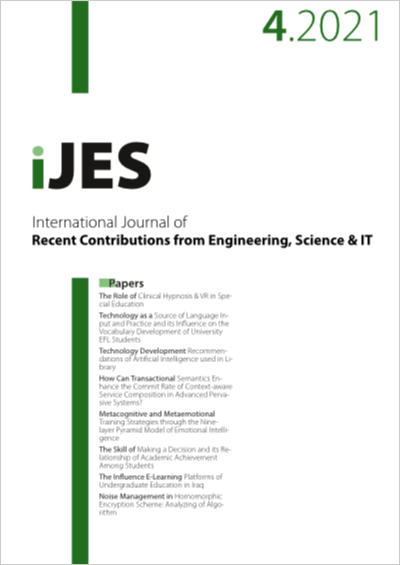Technology as a Source of Language Input and Practice and its Influence on the Vocabulary Development of University EFL Students
DOI:
https://doi.org/10.3991/ijes.v9i4.24715Keywords:
Technology, vocabulary learning, multimedia, English languageAbstract
This paper addresses the extent to which technology-based language resources and tools influence the vocabulary development among University students learning English as a foreign language (EFL). The vocabulary development of 184 undergraduate students at the University of xxxxxxxx (xxxxxxx) is studied in terms of the growth of their receptive vocabulary size as well as their use of vocabulary learning strategies (VLS) across three years, and any possible correlation between this development and the use of technology is analysed. Findings reveal that for the majority of the population, the highly frequent use of multimedia tools was largely confirmed; however, for most students there was no significant correlation between the use of such resources and the growth pattern of their vocabulary knowledge. Only the low-intermediate students who had just joined the university were the exception, as their use of Internet to search for information or to communicate with others seemed to be significantly correlated to their vocabulary development. These findings have interesting implications for the classroom as they show the high potential of technology-based resources in developing vocabulary especially in environments in which English is taught as a foreign language (FL), and used only in classroom contexts. Learners appear to be "connected" enough and avid of technology based tools; however, they seem to need assistance from instructors to maximize the positive support of such tools on their language learning in general and vocabulary development in particular.
Downloads
Published
How to Cite
Issue
Section
License
Copyright (c) 2021 Adela Talbi Hassani

This work is licensed under a Creative Commons Attribution 4.0 International License.
The submitting author warrants that the submission is original and that she/he is the author of the submission together with the named co-authors; to the extend the submission incorporates text passages, figures, data or other material from the work of others, the submitting author has obtained any necessary permission.
Articles in this journal are published under the Creative Commons Attribution Licence (CC-BY What does this mean?). This is to get more legal certainty about what readers can do with published articles, and thus a wider dissemination and archiving, which in turn makes publishing with this journal more valuable for you, the authors.
By submitting an article the author grants to this journal the non-exclusive right to publish it. The author retains the copyright and the publishing rights for his article without any restrictions.
This journal has been awarded the SPARC Europe Seal for Open Access Journals (What's this?)


